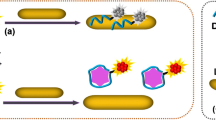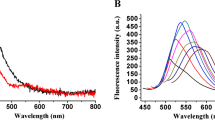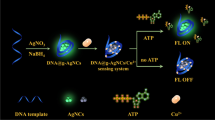Abstract
A ratiometric fluorescent nanoprobe consisting of ssDNA-templated silver nanoclusters (DNA-AgNCs) as dual fluorophore has been constructed for highly sensitive and selective detection of cystein (Cys) and histidine (His). The DNA-AgNCs displays dual emission in that photoexcitation at 470 nm results in weak-green fluorescence peaking at 560 nm, while excitation at 550 nm gives strong red fluorescence with a peak at 595 nm. It is found that copper ions (Cu2+) enhance the green fluorescence but quenche the red fluorescence. A ratiometric nanoprobe for Cys (or His) is designed that is based on the competitive interaction of Cys (or His), Cu2+ and DNA-AgNCs. Cys can be distinguished from His by adding Ni2+ as the masking agent, andr His can be distinguished from Cys by adding N-ethylmaleimide (NEM) as the masking agent, respectively. The limits of detection are 5.1 and 4.5 nM for Cys and His, respectively. Furthermore, the ratiometric fluorescent nanoprobe is used for constructing combinatorial logic circuits in parallel, including OR//NOR and INHIBIT//IMPLICATION (INH//IMP).

Schematic representation of a ratiometric assay based on DNA-AgNCs with dual emission for detection of histidine/cysteine in serum sample. The sensing system are further used to construct combinatorial logic circuits.






Similar content being viewed by others
References
Liu Y, Ding D, Zhen Y, Guo R (2017) Amino acid-mediated ‘turn-off/turn-on’ nanozyme activity of gold nanoclusters for sensitive and selective detection of copper ions and histidine. Biosens Bioelectron 92:140–146
Qiu S, Miao M, Wang T, Lin Z, Guo L, Qiu B, Chen G (2013) A fluorescent probe for detection of histidine in cellular homogenate and ovalbumin based on the strategy of clickchemistry. Biosens Bioelectron 42:332–336
Tong H, Zhao J, Li X, Zhang Y, Ma S, Lou K, Wang W (2017) Orchestration of dual cyclization processes and dual quenching mechanisms for enhanced selectivity and drastic fluorescence turn-on detection of cysteine. Chem Commun 53:3583–3586
Seshadri S, Beiser A, Selhub J, Jacques PF, Rosenberg IH, D’Agostino RB, Wilson PW, Wolf PA (2002) Plasma homocysteine as a risk factor for dementia and alzheimer's disease. N Engl J Med 346:476–483
Jones AL, Hulett MD, Parish CR (2005) Histidine-rich glycoprotein: a novel adaptor protein in plasma that modulates the immune, vascular and coagulation systems. Immunol Cell Biol 83:106–118
Shahrokhian S (2001) Lead phthalocyanine as a selective carrier for preparation of a cysteine-selective electrode. Anal Chem 73:5972–5978
Pace NJ, Weerapana E (2012) Diverse functional roles of reactive cysteines. ACS Chem Biol 8:283–296
Rao ML, Stefan H, Scheid C, Kuttler AD, Froscher W (1993) Serum amino acids, liver status, and antiepileptic drug therapy in epilepsy. Epilepsia 34:347–354
Kim KY, Jung SH, Lee JH, Lee SS, Jung JH (2014) An imidazole-appended p-phenylene-cu (II) ensemble as a chemoprobe for histidine in biological samples. Chem Commun 50:15243–15246
Maheshwaran D, Priyanga S, Mayilmurugan R (2017) Copper (II)-benzimidazole complexes as efficient fluorescent probes for L-cysteine in water. Dalton Trans 46:11408–11417
Li Y, Deng Y, Zhou XD, Hu JM (2018) A label-free turn-on-off fluorescent sensor for the sensitive detection of cysteine via blocking the Ag+-enhancing glutathione-capped gold nanoclusters. Talanta 179:742–752
Feng T, Chen Y, Feng BB, Yan JJ, Di JW (2019) Fluorescence red-shift of gold-silver nanoclusters upon interaction with cysteine and its application. Spectrochim Acta 206:97–103
Lu W, Gao Y, Jiao Y, Shuang S, Li C, Dong C (2017) Carbon nano-dots as a fluorescent and colorimetric dual-readout probe for the detection of arginine and Cu2+ and its logic gate operation. Nanoscale 9:11545–11552
Tang Z, Lin Z, Li G, Hu Y (2017) Amino nitrogen quantum dots-based nanoprobe for fluorescence detection and imaging of cysteine in biological samples. Anal Chem 89:4238–4245
Lu HZ, Xu SF (2017) Visualizing BPA by molecularly imprinted ratiometric fluorescence sensor based on dual emission nanoparticles. Biosens Bioelectron 92:147–153
Elsutohy MM, Chauhan VM, Markus R, Kyyaly MA, Tendler SJ et al (2017) Real-time measurement of the intracellular pH of yeast cells during glucose metabolism using ratiometric fluorescent nanosensors. Nanoscale 9:5904–5911
Pratiwi FW, Hsia CH, Kuo CW, Yang SM, Hwu YK et al (2016) Construction of single fluorophore ratiometric pH sensors using dual-emission Mn2+-doped quantum dots. Biosens Bioelectron 84:133–140
Wang TL, Tao ZH, Lyu YL, Qian PC, Li YF, Lin XD, Wang S, Liu YQ (2018) A reusable ratiometric fluorescent biosensor with simple operation for cysteine detection in biological sample. Sensors Actuators B Chem 277:415–422
Duan YF, Ning Y, Song Y, Deng L (2014) Fluorescent aptasensor for the determination of salmonella typhimurium based on a graphene oxide platform. Microchim Acta 181:647–653
Richards CI, Choi S, Hsiang JC, Antoku Y, Vosch T et al (2008) Oligonucleotide-stabilized ag nanocluster fluorophores. J Am Chem Soc 130:5038–5039
Sharma J, Rocha RC, Phipps ML, Yeh HC, Balatsky KA et al (2012) A DNA-templated fluorescent silver nanocluster with enhanced stability. Nanoscale 4:4107–4110
Feng C, Tu J, Liang C, Yang B, Chen C, Chen X (2016) Fluorescent drug screening based on aggregation of DNA-templated silver nanoclusters, and its application to iridium (III) derived anticancer drugs. Microchim Acta 183:1571–1577
Zhou WJ, Zhu JB, Fan DQ, Teng Y, Zhu XQ et al (2017) A multicolor chameleon DNA-templated silver nanocluster and its application for ratiometric fluorescence target detection with exponential signal response. Adv Funct Mater 27:1704092
Wu CT, Fan DQ, Zhou CY, Liu YQ, Wang EK (2016) Colorimetric strategy for highly sensitive and selective simultaneous detection of histidine and cysteine based on G-quadruplex-Cu (II) metalloenzyme. Anal Chem 88:2899–2903
De Silva AP, James MR, Mckinney BOF, Pears DA, Weir SM (2006) Molecular computational elements encode large populations of small objects. Nat Mater 5:787–790
Margulies D, Melman G, Shanzer A (2005) Fluorescein as a model molecular calculator with reset capability. Nat Mater 4:768–771
Huang WT, Shi Y, Xie WY, Luo HQ, Li NB (2011) A reversible fluorescence nanoswitch based on bifunctional reduced graphene oxide: use for detection of Hg2+ and molecular logic gate operation. Chem Commun 47:7800–7802
Freeman R, Finder T, Willner I (2009) Multiplexed analysis of Hg2+ and Ag+ ions by nucleic acid functionalized CdSe/ZnS quantum dots and their use for logic gate operations. Angew Chem Int Ed 48:7818–7821
Li HL, Liu YQ, Dong SJ, Wang EK (2005) DNA-based advanced logic circuits for nonarithmetic information processing. NPG Asia Materials 7:e166
Petty JT, Zheng J, Hud NV, Dickson RM (2004) DNA-templated Ag nanocluster formation. J Am Chem Soc 126:5207–5212
Deschamps P, Kulkarni PP, Sarkar B (2004) X-ray structure of physiological copper (II)-bis (L-histidinato) complex. Inorg Chem 43:3338–3340
Su YT, Lan GY, Chen WY, Chang HT (2010) Detection of copper ions through recovery of the fluorescence of DNA-templated copper/silver nanoclusters in the presence of mercaptopropionic acid. Anal Chem 82:8566–8572
Yang YJ, Huang J, Yang XH, Quan K, Wang H et al (2015) FRET nanoflares for intracellular mRNA detection: avoiding false positive signals and minimizing effects of system fluctuations. J Am Chem Soc 137:8340–8343
Wu P, Yan XP (2010) Ni2+-modulated homocysteine-capped CdTe quantum dots as a turn-on photoluminescent sensor for detecting histidine in biological fluids. Biosens Bioelectron 26:485–490
Wei MJ, Yin P, Shen YM, Zhang LL, Deng JH et al (2013) A new turn-on fluorescent probe for selective detection of glutathione and cysteine in living cells. Chem Commun 49:4640–4642
Acknowledgements
This work is supported by the National Natural Science Foundation of China (No. 21575138 and No. 21775108), and the Tianjin Science and Technology Project (No. 18PTSYJC00130).
Author information
Authors and Affiliations
Corresponding authors
Ethics declarations
The author(s) declare that they have no competing interests.
Additional information
Publisher’s note
Springer Nature remains neutral with regard to jurisdictional claims in published maps and institutional affiliations.
Electronic supplementary material
ESM 1
(DOCX 3.87 MB)
Rights and permissions
About this article
Cite this article
Lin, X., Hao, Z., Wu, H. et al. A ratiometric fluorescent nanoprobe consisting of ssDNA-templated silver nanoclusters for detection of histidine/cysteine, and the construction of combinatorial logic circuits. Microchim Acta 186, 648 (2019). https://doi.org/10.1007/s00604-019-3749-2
Received:
Accepted:
Published:
DOI: https://doi.org/10.1007/s00604-019-3749-2




